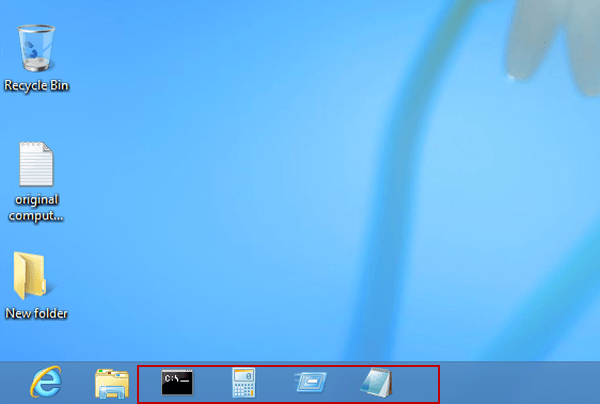

- #WINDOWS 8 FIX BROKEN LINKS PINNED PROGRAMS HOW TO#
- #WINDOWS 8 FIX BROKEN LINKS PINNED PROGRAMS PC#
- #WINDOWS 8 FIX BROKEN LINKS PINNED PROGRAMS WINDOWS#
#WINDOWS 8 FIX BROKEN LINKS PINNED PROGRAMS WINDOWS#
Next, we’ll go through some solutions for fixing broken shortcuts in Windows 10. Those are just two of the most common ways that shortcuts can break. (Below, we’ll walk you through fixing broken shortcuts with missing icons - or you can jump down to that section right now.) Sometimes, you’ll notice a missing icon instead - the Crysis shortcut in the screenshot on the right below shows a blank page instead of the actual icon for the game. The most common cause of broken shortcuts is when the original program file is missing, such as in the case of the deleted Firefox program file seen in the screenshot on the left below. That, in turn, can lead to high CPU usage, and if that happens all the time, you’ll experience higher CPU temperatures. The less efficient your computer is - the more loose ends you have scattered around, including broken shortcuts, temporary files, and other junk files - the less capable it is of delivering top performance. That way, your computer can focus on loading Windows as quickly as possible. If slow boot times are already a problem you’re facing, you can also speed things up by disabling startup programs. Removing and fixing those broken shortcuts can improve your computer’s boot time, since your desktop won’t be as crowded. More importantly, broken shortcuts can negatively affect your computer’s performance, even if you’re not bothered by the inconvenience. What’s the problem with broken shortcuts?įirstly, broken shortcuts are annoying - why have a shortcut taking up space on your desktop if it’s broken and not going to open the program you want? Corrupted or broken shortcuts can happen for a number of reasons. Those links are shortcuts, too!īut any time you use shortcuts, you run the risk of things falling apart. For example, when using Microsoft Word, you can quickly access recently opened files from the File drop-down menu. In addition to desktop shortcuts, you’ll also find shortcuts in the Start menu (as shown in the screenshot below).Īnd shortcuts can also be found within applications themselves. Shortcuts became popular with Windows 95 - before that, you often had to manually enter the path to the programs or files you wanted to use. The shortcut leads to C:\Program Files\Mozilla Firefox\firefox.exe, which is on our hard drive. We create shortcuts in convenient places, like on the desktop, so that we can easily access our favorite apps and programs.Īs shown in the screenshot below, while the Firefox shortcut you see is sitting on the desktop, that isn’t where Firefox is actually installed. What are broken shortcuts?īroken shortcuts are simple icons (plus text) that link to a file often hidden deep on your hard drive.
#WINDOWS 8 FIX BROKEN LINKS PINNED PROGRAMS HOW TO#
Find out how to clean up all your temporary files in our ultimate cleaning guide.
#WINDOWS 8 FIX BROKEN LINKS PINNED PROGRAMS PC#
Press OK, then click Clean Now.Īfter your PC reboots, you’ll see that all your missing shortcuts and icons have been restored. Select Windows Cache files and make sure that Icon Cache files are selected for cleaning. Instead, repair them automatically with AVG TuneUp.ĭownload AVG TuneUp and head over to the Disk Cleaner category. But finding and deleting them manually can be both tricky and tedious. To fix these broken shortcuts in Windows 10, you need to delete the icon files. These database files can easily get corrupted, resulting in missing or incorrect icons for your shortcuts. Windows temporarily stores your file icons inside a file called thumbs.db, which sits in various folders on your hard drive. If some of your desktop shortcuts are missing their icons, the following trick can help. Here you can restore any missing desktop shortcuts you might have enjoyed in earlier Windows versions. On the left-hand side, click Themes and then select Desktop icon settings on the right (or down below under Related Settings). Right-click your desktop and select Personalize. If you’re missing some essential shortcuts like My Computer, Documents, or the Control Panel, it’s easy to bring them right back onto your desktop.

If it did the trick - great! If not, read on. The resulting process may take some time to complete. The following command will check your entire Windows system for errors, restoring original files if necessary.Įnter the command DISM /Online /Cleanup-Image /RestoreHealth and press Enter. That should clear things up, but if not, you’ll need to bring out the heavy artillery. That command will repair some key Windows system files, including Windows’s ability to handle shortcuts. In the Command Prompt window, type in the command sfc /scannow and press Enter. Open the Start menu, type in cmd, right-click on the result, and select Run as administrator. Try the following techniques to fix those broken shortcuts in Windows 10. What if your original files are still present, but your desktop shortcuts are still not working? In that case, it may be a problem within Windows itself.


 0 kommentar(er)
0 kommentar(er)
